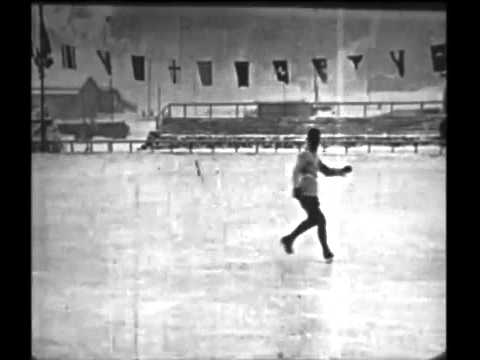This rare footage is actually the official Figure skating film of the 1924 Winter Olympic Games from Chamonix, France. It was made by Jean de Rovera and is thought to be the first commercially available film of the Olympic Games.
https://youtu.be/GBN7KcBe-Ik
The 1924 Winter Olympics, officially known as the I Olympic Winter Games was held in Chamonix, France. Originally called Semaine Internationale des Sports d’Hiver (“International Winter Sports Week”) and held in association with the 1924 Summer Olympics, the sports competitions were held at the foot of Mont Blanc in Chamonix, andHaute-Savoie, France between January 25 and February 5, 1924. The Games were organized by the French Olympic Committee, and were in retrospect designated by the International Olympic Committee (IOC) as the I Olympic Winter Games.
The tradition of holding the Winter Olympics in the same year as the Summer Olympics would continue until 1992, after which the current practice of holding a Winter Olympics in the second year after each Summer Olympics began.
Although Figure Skating had been an Olympic event in both London and Antwerp, and Ice Hockey had been an event in Antwerp, the winter sports had always been limited by the season. In 1921, at the convention of the IOC in Lausanne, there was a call for equality for winter sports, and after much discussion it was decided to organize an “international week of winter sport” in 1924 in Chamonix.
The history of figure skating stretches back to prehistoric times. Primitive ice skates appear in the archaeological record from about 3000 BC. Edges were added by the Dutch in the 13th or 14th century. International figure skating competitions began appearing in the late 18th century—in 1891.
In the beginning of the 20th century, figure skating was lent a more athletic character through the developments of Ulrich Salchow, a Swede. Salchow was considered the greatest figure skater of his day by far, winning the world championships ten times. The crowning achievement of his career, however, was his development of ice skates with slightly serrated blades, giving enough traction on the ice to launch long jumps. The salchow jump, still used prominently in figure skating routines today, is named for him, and was considered Salchow’s greatest contribution to figure skating.
Figure skating’s Olympic debut came at the 1908 Summer Olympics—it was the first winter sport introduced to the Olympics.The competition included men’s singles, ladies’ singles, pairs, and special figures.
The largest public ice rink in the world, the Sportpalast in Berlin, opened in the 1910s. The rink had an area of 2,400 m2 (25,800 ft2), with dimensions of 60 m by 40 m (197 ft by 131 ft). The new rink increased both the public interest in figure skating as well as the number of people who practiced the sport. Many new figure skaters came from Germany, among them Werner Rittberger and Charlotta Oelschägel. Rittberger invented another jump, at first named eponymously, but eventually changed to the name it is known by today, the loop jump. Oelschlägel won a championship in the United States at the age of 17, and had a professional career spanning ten years.
No major international championships were held from 1915–1921 due to World War I and the post-war recovery. In 1922, the World and European Championships were renewed and in 1924 figure skating was part of the first Winter Olympics, held in Chamonix, France. Norway’s Sonja Henie and Austria’s Karl Schäfer dominated the sport during the inter-war period. Henie, a ten-time world champion, brought a new style to figure skating in both athletic practice and dress. Previously, female figure skaters had skated in bulky clothing and long skirts. Henie broke with tradition by wearing a short knee-length skirt during her routines. In addition, her fluid and unlabored movements and overall elegance were considered to be a major advancement for figure skating. In the period from 1929 to 1936, Schäfer won the European title eight times and the World title seven times.
Although the Russian Empire hosted the first World Championships and Nikolai Panin won gold in special figures at the 1908 Olympics, its successor state, the Soviet Union, was largely absent from international figure skating competitions for several decades.
